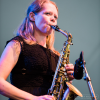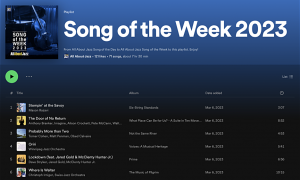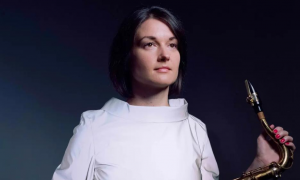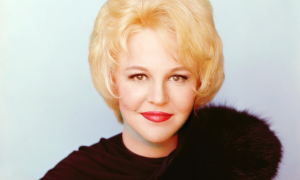Home » Jazz Articles » My Playlist » Caroline Davis
Caroline Davis
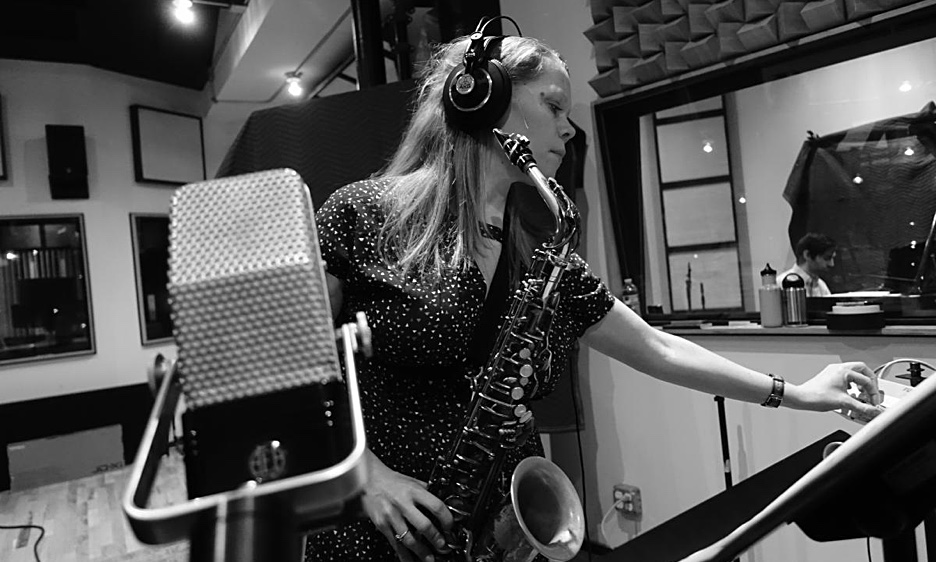
1. Arthur Russell, Tower of Meaning (Chatham Square, 1983)
I started listening to Arthur Russell back in 2009, and there is so much music to listen to (most of it seems to be unreleased). I found out about this record from Peter Zummo when I saw him playing at the Queens museum for ETERNiDAY in 2014 with a band called Bear 54. Peter plays trombone and was a frequent collaborator of Russell's back in the 70s. He mentioned this one in conversation, but it took me a while to sit down and listen to it. This album, originally released on Philip Glass's label, is unique in that it's completely instrumental, and because of Russell's vision of orchestral music. All the music was intended to accompany a play by Robert Wilson, but it didn't work out, so it was just released as is. Side A includes several pieces that end abruptly, perhaps not planned, and side B is just one long piece. In general, the music on this album kind of stands still in a weird way, there aren't any grandiose rhythmic events or modulations, but I hear movement through a visual medium, if that makes any sense. It's raw and piecemeal, which are both qualities I love about his music. I wouldn't say this is my favorite of his, but, Arthur, I hear you!
 2. Warne Marsh, Ne Plus Ultra (hatOLOGY, 1970)
2. Warne Marsh, Ne Plus Ultra (hatOLOGY, 1970) I came to know Warne Marsh through the inimitable Lee Konitz, who often says he's the best there ever was. This is a good album that I found out about through Stafford Chamberlain's book, "An Unsung Cat." Apparently it was Marsh's first recording as a leader since 1958 when he recorded with Paul Chambers and Paul Motian. What a long period that was not to record under his own name. It's interesting to have Gary Foster and Warne on the same album during this part of their careers because they sound so alike. It some moments it can be off-putting, but at the same time remarkably beautiful. Dave Parlato, who played bass with Frank Zappa and is father to vocalist Gretchen Parlato, and John Tirabasso, another LA staple, round out the quartet. What a free record—from note one it's as if they are on a divine plane, existing for the music alone. Improvisation is the number one concern here, and it stands tall within all the tracks from the standards, the lines, the free playing, and the Bach invention. It's raw, it's unplanned, and it's the truth.
3. Louis Cole, Louis Cole (Autoprodotto, 2010)
Found out about this one by way of some friends out West, as I believe he lives out there and studied jazz somewhere in L.A. I checked out some music from his other band, called Knower, recently, and I actually prefer his solo stuff to those records for reasons of musical sensitivity. This isn't a jazz record and doesn't pretend to be one. It's one of the most sonically interesting albums I've heard in a while; there's so much going on underneath the music by way of post-production or layering of different sounds. A couple tracks are instrumental, but most include his angelic singing, which sometimes goes way up in that falsetto. Every track is good; the music grooves and its message runs deep.
 4. Steve Coleman, Synovial Joints (Pi Recordings, 2015)
4. Steve Coleman, Synovial Joints (Pi Recordings, 2015) I came to know Steve's music through Von Freeman when I was living in Chicago. Steve is from there, and he often came through to the New Apartment Lounge where Von had his weekly gig and jam session. He has released so much music over the years, but this is one of his most recent releases and features all kinds of instrumentalists including strings, woodwinds, and Jen Shyu singing her heart out, in addition to his normal group. I love this album in every way, I've been listening to it ever since it came out last year, and I just can't stop, because I hear something new every time I listen to it. The complexity has always been an attractive quality to my ears, but Steve has a way of presenting it in the kindest of ways, especially in this setting. His melodies, lines, and especially rhythmic transformations are so intriguing to me, so I'm on the path to understanding more about his compositional process by way of personal communication.
5. The Shins, Oh, Inverted World (Sub Pop Records, 2001)
This is really a retreat back to my youth, as I knew about The Shins but never listened hard enough. Many people will know their music as featured in the movie "Garden State," but I heard about them in the 90s when they were touring with Califone. This is their first album, and I prefer it to most of the others. There's something strangely intriguing about James Mercer's voice for it's deadpan delivery. He can also belt it out, as I've come to know on later records from this band. It's a fun album, and there are all kinds of subtleties like the sound of a cat purring to pop rocks fizzing in mouths to kids laughing—it's all very nostalgic for me. I also hear tons of influence from the Beach Boys and the Beatles, which are also bands I love.
 6. Herbie Hancock, Inventions and Dimensions (Blue Note, 1963).
6. Herbie Hancock, Inventions and Dimensions (Blue Note, 1963). Another album that I've had for a while but I'm really diving into it at the moment. This is Herbie's third album as a leader. I came to know Herbie as a sideman with Miles Davis, but his own albums have been so valuable to my own growth as a musician. I'm pretty sure most of this music is composed in the moment, and it's really cool to hear how he, Paul Chambers, Willie Bobo, and Osvaldo Martinez deal with that process of freely improvising. What a cast of characters, I'm surprised by how fun it is to listen to. I read on the liner notes that one influence for this record was Herbie's recent musical meeting with Eric Dolphy, which was apparently one of his first experiences with "free" music. The whole session was a big experiment, and I'm so glad he made that leap of faith. It inspires me to do the same.
7. J Dilla, The Shining (BBE Records, 2006)
I don't think you can go very far in the world of music without hearing his name. Got this album a while ago, but I'm revisiting it to learn about the samples and production. This album was unfinished when he died, and Karriem Riggins helped to finish and release it in full. All kinds of my favorite collaborators on this one—Common, Dwele, D'Angelo, Madlib, Black Thought and of course Busta Rhymes blasting it from the start. I was inspired to go back after listening to the new compilation (Lost Scrolls) that was released earlier this year. I like trying to find the samples, but mostly I have to ask people who really know what's up or search around. My personal favorites are from The Isley Brothers' Footsteps in the Dark and Dick Hyman's Moog sounds on Alfie. And I love hearing Dilla's calming voice on the last track. His innovations went unsurpassed when he left us, and I still feel that way when listening to these creations.
 8. Lee Konitz, Satori (Milestone, 1975)
8. Lee Konitz, Satori (Milestone, 1975) I literally just started listening to this album, so my thoughts on it are pretty unformed. Lee has been an influence on my playing since the beginning; I learned of him through Miles Davis' Birth of the Cool sessions. I'm slowly making my way through all of Lee's albums, and this one caught my interest since he didn't record much with this outfit, with Martial Solal, Dick Katz, Dave Holland, and Jack DeJohnette. Also how could I deny the cover—he's just looking down passively at his horn on the cover, haha! There's no holding back on this one, they're all just going for it. Lee's playing is wild, and I think it's partly because of the company. He's still very much himself, but these guys are egging him on in the best of ways from the pointed comping to the colorful cymbal crashing. It's a different kind of band than I'm used to hearing accompany Lee—lots of things going on, some have tact, others not. I'll keep listening.
9. Charles Brown, Driftin' Blues (The Best of) (Aladdin, 1992)
Charles Brown has one of the most mellow voices I've ever heard. I think the first time I heard it was while watching the movie "Home Alone" but I didn't realize it was him until later. My boyfriend is always giving me great music to check out, and he gave me this compilation just a couple weeks ago, and it is something I'll cherish for a while, from the romantic lyrics to that perfect guitar sound. This compilation spans a large amount of time from '45 to '56, so there's some discrepancy between tracks, but his sweet voice is a connecting thread. I don't prefer compilations for that reason, but what can you do. I think he also plays piano on all of this music, lots of bluesy and trill-rific offerings there. Also I have heard some of his music sampled by hip-hop producers, so you know he's the real deal. I look forward to hearing more of his music in album form.
 10. Ornette Coleman, Complete Live at the Hillcrest Club (Inner City, 1976)
10. Ornette Coleman, Complete Live at the Hillcrest Club (Inner City, 1976) Since Paul Bley's death i, I've been finding more records that I love with his voice ringing through. I've loved this record for years, but I'm listening to it again to dig deeper. I've actually been into Ornette since I started playing jazz about 15 years ago—his unique voice always made me keep listening, even though my initial reaction wasn't positive. This album is ridiculous—the interaction, the listening, the space, the energy. It has to be ranked amongst one of my favorites with these musicians, and because it's one of Ornette's first live recordings, its even more special. Bley's solos alone force me to step outside of what I consider normal space and time. I mean, if you haven't heard that trio start from "I Remember Harlem," I recommend starting there. But seriously, the whole album offers some serious listening adventures.
Foto: Luigi Santosuosso
< Previous
SFJAZZ Collective: Remembering Miles
Next >
Day and Night
Comments
About Caroline Davis
Instrument: Saxophone
Related Articles | Concerts | Albums | Photos | Similar ToTags
Caroline Davis
What I'm Listening to Now
Vincenzo Roggero
Chicago
New York
Matt Mitchell
Warne Marsh
Lee Konitz
Paul Chambers
Paul Motian
Gary Foster
Frank Zappa
Gretchen Parlato
John Tirabasso
Louis Cole
Steve Coleman
Von Freeman
Jen Shyu
Herbie Hancock
Miles Davis
Willie Bobo
Eric Dolphy
Martial Solal
Dick Katz
Dave Holland
Jack DeJohnette
Charles Brown
Ornette Coleman
Paul Bley
Concerts
For the Love of Jazz
 All About Jazz has been a pillar of jazz since 1995, championing it as an art form and, more importantly, supporting the musicians who create it. Our enduring commitment has made "AAJ" one of the most culturally important websites of its kind, read by hundreds of thousands of fans, musicians and industry figures every month.
All About Jazz has been a pillar of jazz since 1995, championing it as an art form and, more importantly, supporting the musicians who create it. Our enduring commitment has made "AAJ" one of the most culturally important websites of its kind, read by hundreds of thousands of fans, musicians and industry figures every month.

